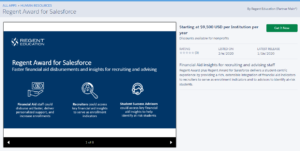Enhanced portal increases effective student communication while empowering students with their own financial aid management resource
Frederick, MD – Regent Education, the leading provider of financial aid management software solutions for higher education institutions, today introduced multilingual capabilities to its Student Self Service Portal. The multilingual portal is a component of Regent Enterprise, a Financial Aid Management System that enables institutions to automate and manage every aspect of the financial aid life cycle.
Regent’s Student Self-Service Portal, which may be deployed on its own or integrated with an institution’s existing student portal, lets students manage their financial aid and communicate with the financial aid office while on the go, 24/7, from their laptop, PDA or cell phone. This real-time information is automatically updated in an institution’s financial aid files along with change tracking capabilities. This comprehensive system even generates personalized award status letters to students, imprinted with school’s logo and colors. Additionally, Regent’s multilingual design supports the needs of an increasingly international population, enabling students to work in their language of choice.
The Regent Enterprise Student Self Service Portal offers key benefits such as:
- Student information populated real-time as you process
- Viewing, accepting/rejecting awards in real-time
- Viewing of application status and academic progress status
- Viewing of messages to student
- Clicking on outstanding requirements for links to downloadable forms or additional information
- Viewing of loan history information for help with debt management/counseling.
“Regent Enterprise is a student centered collection of tools that automates the financial aid processes and interactions between institutions and students, enabling an institution to better communicate with the 21st century student,” said Leonard Gude, Regent’s Vice President of Financial Aid Solutions. “Regent continuously strives to offer solutions that meet the needs of institutions’ ever-growing, diverse student populations.”



